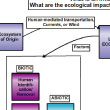Ocean Literacy Principle 5F: Ocean habitats are defined by environmental factors. Due to interactions of abiotic factors such as salinity, temperature, oxygen, pH, light, nutrients, pressure, substrate and circulation, ocean life is not evenly distributed temporally or spatially, i.e., it is “patchy”. Some regions of the ocean support more diverse and abundant life than anywhere on Earth, while much of the ocean is considered a desert.
| |
|
|
|
| Scientist map | | Consensus map |
What Leads to the Successful Establishment of Invasive Species and What Are the Impacts? Kari Heinonen (scientist) and educators Bethann Balazsi, Colin Lawson, and Margaret Tower
Save map to CMB: Scientist Map | Consensus Map
Download (pdf): Scientist Map | Consensus Map
Dr. Heinonen’s maps were designed to answer questions about the success and impact of invasive species. On her "To Educators" map, the box at left shows factors that determine whether or not an invasive species will become established in its new ecosystem and start a reproducing population. Working with educators helped her create a more easily understandable map. It was classified into different sections, and a color-coded legend was added. Her team felt that these seemingly small changes drastically improved the flow of the map. They also added the "Risk Assessment" and "Best Management Practices" concepts to enable teachers and students to discuss the types of actions communities are implementing to deal with invasive species. Educators also liked that this collaborative map was general and flexible enough to be utilized with nearly any invasive species exploration.
| |
|
|
|
| Scientist map | | Consensus map |
Peter Jumars (scientist), students Nicolas Record and Kristen Wilson, and post-doc Ian Salter
Save map to CMB: Scientist Map | Consensus Map
Download (pdf): Scientist Map | Consensus Map
The concept maps Dr. Jumars helped to create attempt to explain how environmental processes and disturbances negatively or positively affect benthic organisms. Reflecting upon his first concept map, he realized this version was really more of an assigned diagraph than a true concept map. He sees that changes between variables can be more easily shown in a graphical representation (x and y axis plot) although a concept map can show the interrelationships between multiple concepts. His team built a consensus map for a new target audience (high school freshman), simplifying the story and highlighting the transition of carbon into or out of marine sediments. Their map took on a completely different look as they thought about how best to address their audience and drive home one key message.
|









